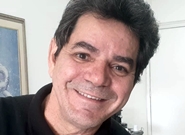 |
|
From
Simonetti
to the
CVV:
experiences
that
mark
lives |
|
|
|
|
|
|
Milton Francisco Puga (photo) is an advertising agent in the Brazilian city of Bauru, in the state of São Paulo. Since arriving in the city in 1981, he has been a volunteer worker at CEAC - the Amor e Caridade (Love and Charity) Spiritist Centre. There, he takes on a number of tasks, including the coordination of their Monday public meetings, which are broadcast live on local radio and Spiritist TV. In this interview, Milton speaks about his friendship with the late Spiritist writer, Richard Simonetti, and his work at CVV, or Centro de Valorização da Vida, a non-profit Brazilian organisation dedicated to suicide prevention:
How have you been able to apply your professional experience with visual presentation to help the dissemination of Spiritism?
Visual presentation is as important to convey the Spiritist message as its overall presentation. It must reflect key aspects of Spiritism, such as integrity, clarity, purity and innovation. That is essential to deliver the “Spiritist product” efficiently to those who need it in order to feed their souls and to be able to give life its proper value. This is especially true at the current period of our planet, when we are going through a transition [from a world of trials and tribulations to a world of regeneration]. These changes have caught so many people off-guard, affecting their balance and their sense of direction.
You designed and illustrated several books written by Richard Simonetti. Which one would you like to highlight?
The most powerful book cover, which had the biggest impact, was the one designed for his best-seller “Quem tem medo da Morte?” (Who’s Afraid of Death?), which was the seventh book he published. The cover has a picture of a burn-out matchstick on a white background. The book title has big, bold fonts. Each chapter of the book comes with very clean illustrations, with a drawing of the main character in very fine lines, representing their spiritual body. This book continues to be a big national and international best-seller. What I really take from this is not so much gratification from the success of the book, but the amazing partnership with Richard, which was one of the best thingsto happen to me in this incarnation.
What are the main guidelines to design a successful book cover or billboard?
In the digital era, marked by such a wide range of media, someone has already said that “Those who are not seen will not be remembered!” Not only that, they won’t be perceived, acquired, downloaded or accessed. That rule applies to every form of communication, from a street billboard to a publication sold in newsagents or social media messages. Any form of communication needs to be attractive, objective, instigating, efficient and it must cause an impact. It must follow the dynamic of the visual language of its time, which changes and develops. And never faster than today, when everything changes in the speed of the internet.
Tell us a bit more about your friendship with Richard.
It’s been said that we are the ones who direct our lives, but that rule has its exceptions. And some of those are really life-changing. That’s what happened when I moved to the city of Bauru. That has had a remarkable impact in my life. One of the many great things that happened to me here was meeting Richard “again,” so to speak. We clicked from day one and he always treated me like a younger brother. From the day we met in 1981 until my final visits to his deathbed on October 3rd, 2018, he always called me Young Man. My friendship with Richard was a constant learning experience. It was a source of pride, honour and privilege to be able to enjoy the wisdom and positive energy of a conscientious, disciplined and committed Spiritist, who was able to put into practice his goals of helping disseminating Spiritism and living according to its core values.
Tell us about your experience with CVV (Centro de Valorização da Vida), the well-known Brazilian suicide prevention NGO.
My involvement with CVV was a natural development stemming from my volunteer work in Spiritism, which pays special attention to the promotion of life. I was first invited to join CVV in Bauru to prevent it from closing its doors. I was meant to work on an advertisement campaign to help raise awareness about their work, but I was so deeply touched by the beauty of their proposals that I joined the group with all the energy that I had. At the time, the World Health Organisation was making an international appeal to warn people about the spread of depression and suicide, particularly amoung young people aged between 14 and 29. It was becoming a silent pandemic. That was the beginning of the international Yellow September campaign, to put an end to that taboo and make people face and address the problem. A similar successful campaign had led to the creation of Pink October, getting the world to face cancer as a reality and push for more efficient public policies, as well as better prevention and treatment protocols.
What are your best memories from all these years in Spiritism?
I thank you for the opportunity to share my memories of someone who, more than anyone else, valued life and worked for the prevention of suicide, through his humanitarian actions, his articles, his talks and lectures and the 65 books he published. That man was Ricard Simonetti. God gave me the privilege of working with him and of working at the CVV suicide prevention group, which was created by a group of young idealistic Spiritists in 1962. They worked hard and were able to keep their discipline and to lead by example. As we know, no dream will ever die if we do our part, as the universe will conspire to turn it into reality. |